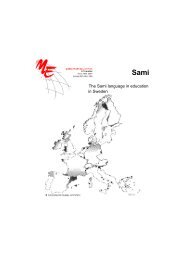Multilingual Early Language Transmission (MELT) - Mercator ...
Multilingual Early Language Transmission (MELT) - Mercator ...
Multilingual Early Language Transmission (MELT) - Mercator ...
Create successful ePaper yourself
Turn your PDF publications into a flip-book with our unique Google optimized e-Paper software.
When Leopold's daughter Hildegard said her first sentences, she combined words from two<br />
languages in one sentence together and was functioning as a monolingual. This (issue) has<br />
set the tone for the study of BFLA until today.<br />
Further issues for research were parent’s and educator’s concerns about bilingual education:<br />
children are at risk of academic failure or delay (e.g. Macnamara, 1966), or BFL learners will<br />
be socio-cultural misfits and identify with neither language group (Diebolt, 1968).<br />
Leopolds finding that bilingual children may mix their languages, sometimes more so in the<br />
early years than later on, gave rise to two opposing positions. Volterra and Taeschner (1978),<br />
on the one hand, concluded that bilingual children do not have any difficulties in<br />
comprehension and may have only one lexical system in the initial development of their<br />
vocabulary. On the other hand, the idea that bilinguals have a lower IQ still exists among<br />
some people. It is one of the persistent myths among monolinguals. Some believe that<br />
bilingual children develop a single, unitary language system at the start, which then slowly<br />
separates into two systems. This myth is hard to overcome, even though research comparing<br />
monolinguals and bilinguals has shown that they score the same on IQ tests (with the same<br />
gender, social class and age).<br />
As Baker stated in the 1990s: “Far from making people mentally confused, bilingualism is<br />
now associated with a mild degree of intellectual superiority” (Baker, 1995: 49).<br />
In 20011, De Groot (2011) describes: “<strong>Multilingual</strong>s have not mentally compartmentalized<br />
their languages in neatly separated sections, with solid firewalls between them, but all of the<br />
languages known interact with one another, both during acquisition and use” (De Groot,<br />
2011: 339).<br />
Until the 1960s, scientific discussions and positions were based on a limited knowledge of<br />
the working processes of the human brain. Since the introduction of the ‘Common<br />
underlying proficiency’ by Cummins (1979, 2000) these assumptions and positions can be<br />
considered as “old theory.”<br />
Illustration 3.1: Separate underlying proficiency. Illustration 3.2: Common underlying proficiency.<br />
The old theory, which remained in use until the late 1950s, was based on the idea that both<br />
languages as such have a place in the cognitive system of the child (figure 3.1) and that these<br />
two languages compete with each other in the development of the vocabulary, articulation,<br />
and quality of speech. Therefore it was said that bilingualism and bilingual upbringing of<br />
58



